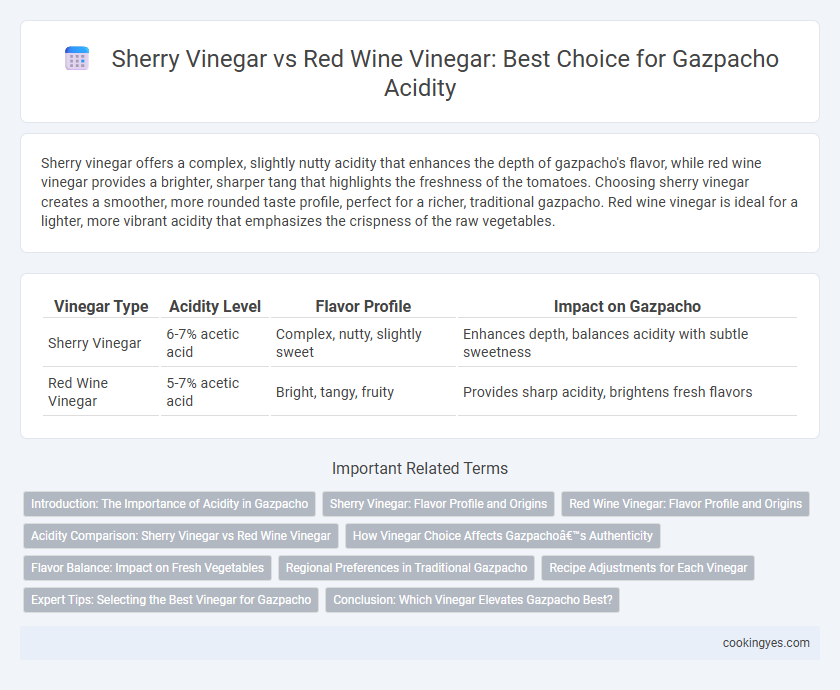Sherry vinegar offers a complex, slightly nutty acidity that enhances the depth of gazpacho's flavor, while red wine vinegar provides a brighter, sharper tang that highlights the freshness of the tomatoes. Choosing sherry vinegar creates a smoother, more rounded taste profile, perfect for a richer, traditional gazpacho. Red wine vinegar is ideal for a lighter, more vibrant acidity that emphasizes the crispness of the raw vegetables.
Table of Comparison
| Vinegar Type | Acidity Level | Flavor Profile | Impact on Gazpacho |
|---|---|---|---|
| Sherry Vinegar | 6-7% acetic acid | Complex, nutty, slightly sweet | Enhances depth, balances acidity with subtle sweetness |
| Red Wine Vinegar | 5-7% acetic acid | Bright, tangy, fruity | Provides sharp acidity, brightens fresh flavors |
Introduction: The Importance of Acidity in Gazpacho
Acidity in gazpacho enhances the refreshing taste and balances the sweetness of ripe tomatoes, making it a crucial aspect of the recipe. Sherry vinegar offers a complex, nutty acidity with subtle sweetness, enriching the flavor profile and complementing the vegetable ingredients. Red wine vinegar provides a sharper, more straightforward acidity that brightens the gazpacho without overwhelming the delicate tomato base.
Sherry Vinegar: Flavor Profile and Origins
Sherry vinegar, with its rich, nutty flavor and complex acidity, originates from the Jerez region of Spain, enhancing gazpacho's depth and authenticity. Unlike red wine vinegar, Sherry vinegar offers a smoother, less sharp acidity that complements the freshness of tomatoes and vegetables without overpowering them. Its aged, barrel-matured profile adds subtle sweetness and umami, balancing the gazpacho's bold flavors and traditional Andalusian character.
Red Wine Vinegar: Flavor Profile and Origins
Red wine vinegar, made from fermented red wine, delivers a balanced acidity with fruity and mildly tart undertones that enhance the fresh vegetables in gazpacho without overpowering its delicate flavors. Originating primarily from Mediterranean regions like Spain and Italy, this vinegar complements traditional gazpacho recipes by adding depth and complexity. Its robust yet smooth profile contrasts with the sharper, nuttier taste of sherry vinegar, making red wine vinegar a versatile choice for achieving the ideal acidity in cold Spanish soups.
Acidity Comparison: Sherry Vinegar vs Red Wine Vinegar
Sherry vinegar provides a complex acidity with nutty and slightly sweet undertones that enhance gazpacho's flavor profile, offering a balanced tang without overpowering the fresh ingredients. Red wine vinegar delivers a sharper, more straightforward acidic bite that brightens the soup but can sometimes dominate the delicate vegetable notes. Choosing sherry vinegar results in a smoother, more rounded acidity, while red wine vinegar offers a brighter, more pronounced tartness, influencing the overall taste and mouthfeel of gazpacho.
How Vinegar Choice Affects Gazpacho’s Authenticity
Sherry vinegar imparts a distinctive nutty and slightly sweet acidity essential for authentic Andalusian gazpacho, preserving the traditional flavor profile rooted in southern Spain. Red wine vinegar offers a sharper, more robust acidity that can overpower the subtle balance of fresh tomatoes and vegetables, deviating from classic recipes. Choosing sherry vinegar maintains gazpacho's regional authenticity by enhancing its characteristic depth and smoothness.
Flavor Balance: Impact on Fresh Vegetables
Sherry vinegar provides a richer, nuttier acidity that enhances the natural sweetness of fresh tomatoes and cucumbers in gazpacho, creating a well-rounded flavor balance. Red wine vinegar offers a sharper, more pronounced acidic bite, which can highlight the crispness of peppers and onions but may overpower delicate vegetable notes. Choosing sherry vinegar results in a smoother, more harmonious blend, while red wine vinegar emphasizes brightness and tanginess in the chilled soup.
Regional Preferences in Traditional Gazpacho
Sherry vinegar, originating from Spain's Jerez region, imparts a complex, nutty acidity that aligns with authentic Andalusian gazpacho recipes, preserving the soup's traditional taste profile. Red wine vinegar, more commonly used in other Mediterranean variants, offers a sharper and more straightforward acidity, highlighting regional preferences outside southern Spain. The choice between Sherry vinegar and red wine vinegar reflects geographic culinary heritage, influencing the balance of acidity and flavor depth in classic gazpacho preparations.
Recipe Adjustments for Each Vinegar
Sherry vinegar provides a rich, nutty acidity that enhances gazpacho's depth, requiring a smaller quantity--typically one tablespoon per liter of soup--to avoid overpowering the fresh flavors. Red wine vinegar offers a brighter, sharper acidity, often needing slightly more--around one and a half tablespoons per liter--to balance the sweetness of tomatoes and peppers. Adjusting the vinegar amount based on its strength and flavor profile ensures the gazpacho maintains a harmonious, refreshing acidity.
Expert Tips: Selecting the Best Vinegar for Gazpacho
Expert tips recommend Sherry vinegar for gazpacho due to its complex, nutty flavor that enhances the soup's depth without overpowering the fresh ingredients. Red wine vinegar offers a sharper acidity that can brighten gazpacho but may compete with tomato sweetness if used excessively. Balancing the vinegar type and quantity ensures optimal acidity and authentic Andalusian taste.
Conclusion: Which Vinegar Elevates Gazpacho Best?
Sherry vinegar enhances gazpacho with a complex, nutty acidity that complements the soup's fresh vegetables, while red wine vinegar offers a brighter, sharper tang. The choice depends on desired flavor depth: sherry vinegar provides a richer, more balanced profile, whereas red wine vinegar delivers a crisp, lively bite. For a traditional, well-rounded gazpacho, sherry vinegar is often preferred to elevate the dish's authenticity and depth.
Sherry Vinegar vs Red Wine Vinegar for gazpacho acidity Infographic

 cookingyes.com
cookingyes.com